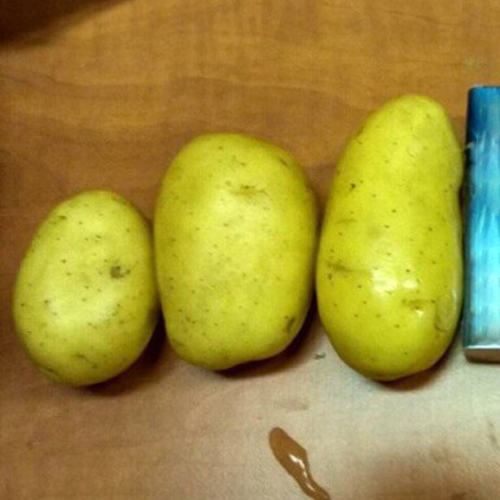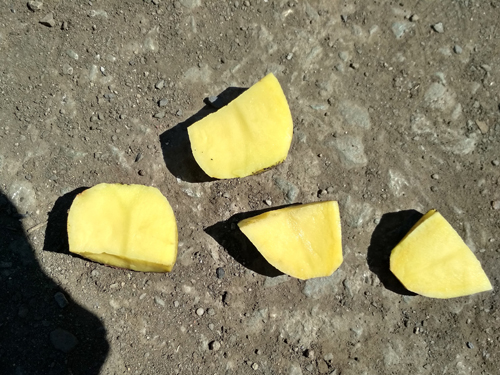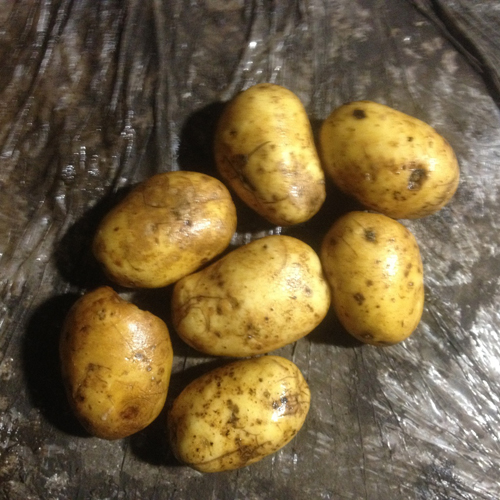Zekura potato variety
Zecura is a German table potato variety (Solanum tuberosum) of medium early ripening. Bred by employees of Solana GmbH & CO KG in the early 90s. It was included in the State Register of Breeding Achievements of the Russian Federation in 1997. Zoned in six regions: Volgo-Vyatka, Central Chernozem, North Caucasian, Middle Volga, West Siberian, Far East. It is famous for its excellent taste and stable yield. Suitable for growing both on an industrial scale and in small areas for personal consumption.

The time from the emergence of full shoots to harvest is 80-95 days.
The plant is of medium height, compact, intermediate type, moderately spreading. The leaves are simple, open, light green. The flowers are red-violet in color, collected in small corollas. The base of the sprout is also reddish-purple.
The root system of the variety is well developed, up to 20 tubers with an average weight of 59-150 grams can form on one plant. Potato nests are very compact, located close to the surface, which makes harvesting much easier. Tubers are oval, oblong. The peel is smooth, yellow in color. The pulp on the cut is yellow; it does not darken when cut and heat treated. The eyes are small, few in number, and superficial.
The marketable yield of Zekura, according to the results of state tests, amounted to 195-323 c / ha, 21-43 c / ha more than indicators Nevsky... The largest amount was collected in the Oryol region - 365 centners were obtained from one hectare, 16 centners per hectare higher than the results of Post 86. The marketability of tubers is 79−96%, at the standard level. Keeping quality is high - 98%.

Excellent taste. The variety belongs to culinary type B (according to the EAPR classification - European Association for Potato Research), that is, to the group of medium-boiling varieties. Tubers are suitable for preparing a wide variety of dishes, are equally well suited for both mashed potatoes and deep-fried, perfectly complement soups, salads and vegetable mixes, and will also look great as an independent dish. After heat treatment, the tubers retain their shape and color, which makes them look very appetizing. The pulp has a pleasant consistency, without excessive wateriness or dryness, when finished, it is medium crumbly. It contains about 13−18.2% starch, which is higher than the established standard for Nevsky.
Initially, Zekura was bred by German breeders for the purpose of cultivating it in Central Europe, so it shows the best yield in the Central Black Earth Region of Russia. However, the variety has a very good adaptation to climatic conditions and different soils, thanks to which it is successfully grown in many regions of the country. This potato is drought-resistant, but at the same time feels calm on soils with high humidity. In care, it is undemanding, but responds very well to watering and feeding, as well as to standard agricultural techniques. Here are some guidelines to help you get the most out of your crop.

- The plot for growing the variety must be properly prepared. This is plowing, and harrowing, and the introduction of a sufficient amount of fertilizer, if required.
- Planting is best done in early to mid-May, when the soil warms up to + 10−12 ° C and the danger of recurrent frosts has finally passed.
- Due to the rather powerful root system of Zekura, the tubers must be planted at a greater distance from each other - about 40-50 cm.The depth of the planting holes should be about 10 cm on light soils, on heavy ones - from 8 cm or less.
- Plants respond well to watering and loosening of the soil. They endure a short-term drought persistently, but a long time without moisture is destructive for them. The best solution is to install automatic irrigation systems, especially in southern regions with hot summers.In the northern regions, watering of potatoes should be carried out in a timely manner, as needed.
- During the period of tops formation, it is very important to carry out regular weeding.
- Do not forget about hilling, preventive treatments for pests and diseases, as well as feeding. The dosage and composition of the fertilizers applied is adjusted based on the characteristics of your soil; the originator does not provide any specific recommendations.

- Maintain crop rotation at the site. It is best to plant potatoes where previously crops such as cucumber, zucchini, cabbage, onions, garlic, beets, legumes, green manure grew.
- Update your seed in a timely manner. This will provide you with a stable yield of marketable tubers, large and even. Our hero has a weak tendency to degeneration, so this event can be held once every 7-8 years.
Zecura is resistant to cancer and golden cyst nematode, weakly susceptible to leaf rolling, very rarely affected by viruses A and Y, common scab, glandular spot, late blight of tops and tubers. Added to this long list of invulnerabilities is the resistance of tubers to rot in wet soil. As for pests, with timely preventive treatment, plants are not susceptible to them.
Gardeners are very positive and even admirable about this variety. Its excellent taste is especially appreciated - many potato growers refused to grow other varieties in favor of our hero because of his taste, he is so good! Also, its undemanding care is distinguished separately. According to gardeners, even with the smallest attention to plants, they are capable of producing a very large amount of harvest. A rare variety can boast of such unpretentiousness! In addition, Zekura perfectly adapts to almost any climatic conditions and soil types, due to which it is actively cultivated almost throughout Russia. It is impossible not to mention the drought tolerance of the variety, which allows it to be cultivated in regions with hot summers.
Another big plus is the resistance of this potato to a large list of diseases. Tubers do not even need to be pickled before planting! And, by the way, it is not necessary to germinate them. Thus, seedbed preparation will take you the least amount of time.
And, of course, one of the main advantages of this variety is its high yield. Tuber crops are formed amicably, in one nest there are a lot of them, moreover, there are relatively few small items. And what a presentation they have! Smooth, large, as in the selection. And even with long-term storage, they still look great, until the spring of next year, while maintaining their excellent taste.
As for the shortcomings, they could not be found for more than 20 years of the existence of this potato. Maybe it is inferior in yield to some of the more modern mid-early varieties, but in terms of its reliability and stability it clearly gives them a head start! Zekura has been tested by many years of experience of gardeners in many parts of Russia, and by choosing it, you can be sure that you will not be left without a crop.
The Zekura variety is officially cultivated by: CJSC Samara-Solana in the Samara Region, CJSC Oktyabrskoye and CJSC Breeding Plant Prinevskoye in the Leningrad Region, LLC Agrofirma Krimm in the Tyumen Region, LLC Elite Potato in Tatarstan, FGBNU "VNII Potato Farm named after A. G. Lorkh" in the Moscow Region, branch of FGBU "Rosselkhoztsentr" in the Irkutsk Region, LLC "Biolab" and LLC "Molyanov Agro Group" in the Samara Region, FGBNU "Samara Research Institute of Agriculture" ...








